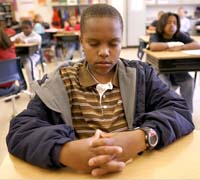 Patricia Leigh Brown delves into the hot topic of meditation training for school-aged kids in this balanced article for the New York Times.
Patricia Leigh Brown delves into the hot topic of meditation training for school-aged kids in this balanced article for the New York Times.
The piece is nice because it’s not a gung-ho endorsement. Some children become calmer and more focused after their meditation lessons. Other kids don’t receive the benefits as readily.
An excerpt:
Although some students take naturally to mindfulness, it is “not a magic bullet,” said Diana Winston, the director of mindfulness education at the U.C.L.A. center. She said the research thus far was “inconclusive” about how effective mindfulness was for children who suffered from trauma-related disorders, for example. It is “a slow process,” Ms. Winston added. “Just because kids sit and listen to the bell doesn’t necessarily mean they’ll be more kind.”
Glenn Heuser, who teaches a combined fourth- and fifth-grade class at Piedmont, said one student started crying about a dead grandparent and another over melted lip balm. “It tapped into a very emotional space for them,” Mr. Heuser said. “They struggled with, ‘Is it O.K. to go there?’ ”
I’d leap for joy if our Montessori school starting teaching mindfulness meditation to the upper grades (the younger kids participate in daily periods of silence). However, here’s a link to a method I endorse even more wholeheartedly for school children since it doesn’t involve sitting still. It’s called Bal-a-Vis-X, and it’s a Brain Gym-inspired mind-body training that requires a student’s focused concentration to coordinate specific tossing, catching and juggling movements. It’s not pure meditation, but it can inspire many of meditation’s best effects.
Bal-a-Vis-X involves juggling small balls or bean bags to counting rhythms with the whole mind engaged. It can be practiced alone or in pairs in school hallways; you don’t need a whole gym. The Kansas schools using this innovative method have seen reading scores go up. I wish more people knew about it. Too bad the website doesn’t have any video on it, but the photos will give you the idea.
More research into all these sorts of calming, brain-organizing therapies for kids and adults is needed, don’t you think?
More from Beliefnet and our partners

